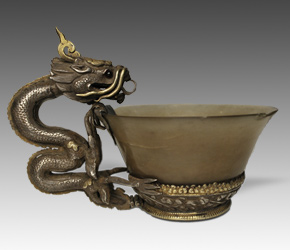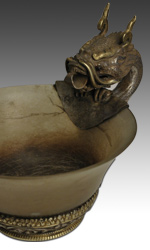Jade Teacup with Dragon Motif
 |
|
"Dragon images date back to Chinese Neolithic stone carvings. Dragons are described as the embodiment of yang principles of heaven, spring, change and creative energy"
This lavishly appointed cup for tea or other sacred libations was clearly a treasured possession of a wealthy monastery or an important high lama within such a community. Finely carved of imported Chinese jade, it was fitted with an ornately carved and gilded silver base and exuberantly writhing dragon handle. Unlike its demonic European counterpart, the Asian dragon is an auspicious creature of great creative and protective power.
 |
|
Dragon images date back to Chinese Neolithic stone carvings and dragons are described in the I Ching (the Chinese oracle known as the book of change) as the embodiment of yang (male) principles of heaven, spring, change and creative energy. The dragon also possesses an elusive or hidden nature, with the ability to transmute its form (or render itself invisible) at will. Thus it was revered by practitioners of both secular and sacred traditions as a supreme protector, in this case of the dharma (or sacred way) itself. A libation cup of this type also calls to mind the kapala or skull cup that traces itself back to early tantric Buddhist practices in India. In both Hindu and Buddhist traditions there, skull cups were sacred implements used for empowerments, offerings and various other ritual practices; they also served wandering monks as a begging and eating bowl. Once Buddhism was well established in Tibet, scull cups were often carved or elaborately mounted with precious metals and jewels.
In Tibetan monasteries the kapala is used symbolically to hold bread or torma (dough cakes)and wine instead of blood and flesh as offerings to wrathful deities, such as the ferocious Dharmapala (“defender of the faith”). The dough cakes are shaped to resemble human eyes, ears and tongues. The kapala is made in the form of a skull specially collected and prepared. It is elaborately anointed and consecrated before use. The cup is also elaborately decorated and kept in a triangular pedestal.
Kapalas are mainly used for esoteric purposes (such as rituals) including: higher tantric meditation to achieve a transcendental state of thought and mind within the shortest possible time; libation to gods and deities to win their favor; by Tibetan Lamas as an offering bowl on the altar, filled with wine or blood as a gift to the Yidam Deity or all the Deities; and the Vajrayana empowerment ceremony. This singularly beautiful and irreplaceable libation vessel is exemplary of both centuries-old Buddhist sacred traditions and the highly developed skills of the stone carvers and metalwork artisans of Tibet.
Download this Article: Jade Teacup with Dragon Motif.pdf